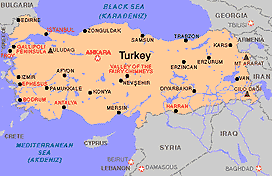| |

Turkey has a history of winemaking longer, probably, than any in the world, but since most of its population is Muslim it might not seem best placed to take advantage of it. Kemal Ataturk did his best to revive the wine industry in the 1920s, but even now, although Turkey has some 600,000ha (nearly 1.5 million acres) under vine, only about 2% of the grapes are turned into wine.
This is not because of a great aversion to alcohol. The population may drink only an average of one litre of wine per head, but they get through 1.5 litres of raki (aniseed-flavoured and 40º alcohol) and four litres of beer. Raki is the drink around which culinary culture is based- wine is for social drinking.. This is aided by Turkish law, which states that wine must be between 11º and 13º alcohol, but hindered by high taxes which raises its price by about 35%; and there is no imported wine.
All this sounds like the recipe for an embattled wine industry, using old techniques to produce wine for a local minority taste, with no awareness of the outside world. But things are not that bad. The vineyard area may be shrinking - by 30% in the 1980s - but yields have risen, particularly in the Aegean and Thrace, so overall production has not fallen by the same amount. And while the government may not actively promote the wine industry, in fact the state-owned producer, Tekel, is the biggest in the country.
State production accounts for some 40% of the total, though neither state nor private sectors are working at full capacity. The grapes are grown by peasant farmers, who sell them to the 22 state -controlled and 109 privately-owned companies, it is quite common for grapes to be trucked long distances from vineyard to winery. At least one private producer, Diren, picks and moves grapes only at night to avoid the risk of spoilage. Most vines are bush-trained and the official number of grape varieties is 1,250, though only 50 or 60 are grown commercially. European varieties tend, not surprisingly, to be concentrated in the west. Production is split almost equally between red and white wines, with only a very little rose made. Vinification and maturation is often in cement or in old wooden barrels, with the larger companies now being equipped to make wine to suit Western tastes.
These wines make a fascinating comparison with those of other Black Sea countries most of which are emerging from collectivized Communist systems. There is the same solidity of fruit, the same old-fashioned and highly characterful reds (old-fashioned need not be a derogatory term). Some whites are not bad, but the high alcohol levels and lack of temperature-controlled fermentation tells against them.
|
|
|
|


